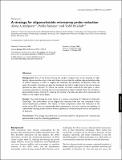A strategy for oligonucleotide microarray probe reduction
Author(s)
Antipova, Alena A.; Tamayo, Pablo; Golub, Todd R.
Downloadgb-2002-3-12-research0073.pdf (80.44Kb)
PUBLISHER_CC
Publisher with Creative Commons License
Creative Commons Attribution
Terms of use
Metadata
Show full item recordAbstract
Background: One of the factors limiting the number of genes that can be analyzed on high-density oligonucleotide arrays is that each transcript is probed by multiple oligonucleotide probes. To reduce the number of probes required for each gene, a systematic approach to choosing the most representative probes is needed. A method is presented for reducing the number of probes per gene while maximizing the fidelity to the original array design. Results: The methodology has been tested on a dataset comprising 317 Affymetrix HuGeneFL GeneChips. The performance of the original and reduced probe sets was compared in four cancer-classification problems. The results of these comparisons show that reduction of the probe set by 95% does not dramatically affect performance, and thus illustrate the feasibility of substantially reducing probe numbers without significantly compromising sensitivity and specificity of detection. Conclusions: The strategy described here is potentially useful for designing small, limited-probe genome-wide arrays for screening applications.
Date issued
2002-11Department
Massachusetts Institute of Technology. Department of Chemistry; Whitehead Institute for Biomedical ResearchJournal
Genome Biology
Publisher
BioMed Central Ltd
Citation
Genome Biology. 2002 Nov 25;3(12):research0073-research0073.4
Version: Final published version
ISSN
1465-6906